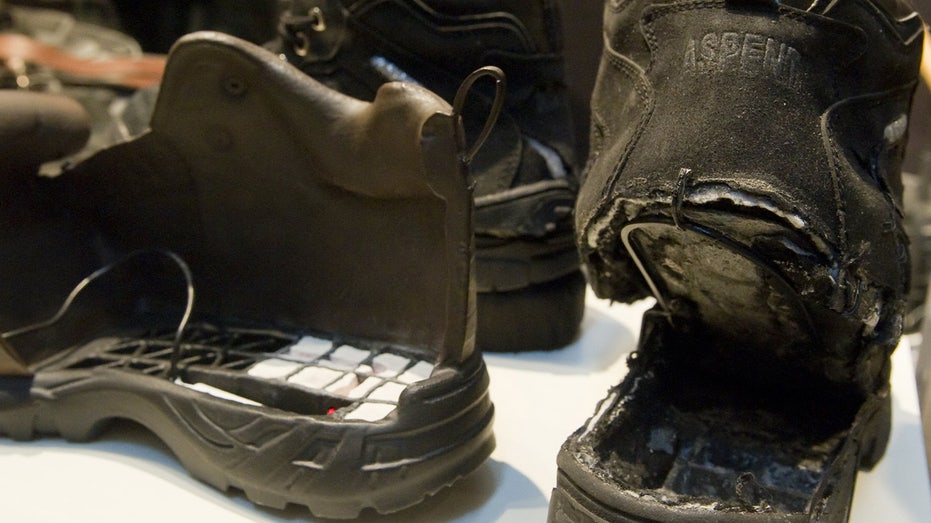
WWW.FOXNEWS.COM
Inside the shoe bomb plot that changed airport security and why the rule is now ending
After nearly two decades of shuffling barefoot through airport security lines, American travelers can finally leave their shoes on.The Department of Homeland Security (DHS) this week ended one of the most visible post-9/11 security measures, a rule born following a failed act of terror in 2001, when a British national, Richard Reid, tried to ignite explosives hidden in his sneakers mid-flight.The attempted terror attack did not succeed, but it sparked a new era of airport screening that would see millions of passengers removing their shoes until now.NEARLY 20-YEAR SHOE-OFF AIRPORT SECURITY POLICY IS ENDED BY TRUMP ADMINISTRATIONThe policys roots trace back to Dec. 22, 2001, when Reid, later dubbed the "Shoe Bomber," boarded American Airlines Flight 63 from Paris to Miami.Hidden in his black high-top sneakers were plastic explosives and a makeshift detonator. Reid attempted to light a fuse with matches mid-flight but was subdued by passengers and flight crew.The incident exposed a vulnerability in aviation security systems, particularly their inability to detect non-metallic threats like PETN, the explosive used in Reids shoes.TSA REVEALS THE SURPRISING REASON PEOPLE MIGHT SET OFF SECURITY ALARMS DURING SCREENINGJeff Price, an aviation security expert and professor at Metropolitan State University of Denver, noted that security machinery at the time could not detect the types of explosives Reid used."As far as shoe removal, the policy, Im sure a lot of people know by now, started back in 2006, when it really dates back to 2001, when Richard Reid tried to blow up an airplane with a shoe bomb," Price said. "But it wasnt until 2006 that the policy would be implemented to remove the shoes. And that was really because the technology at the time couldnt detect the types of explosives that he used or that were in use at the time."In the immediate aftermath of 9/11 and Reids failed bombing attempt, airport security procedures rapidly evolved, but technology lagged behind the threat.Price said that early metal detectors "had a hard time detecting anything at the floor level" and "could never detect explosives."Shoe removal became the human workaround for what machines couldnt yet do."For a long time, the idea was: if we cant see it, well have people take it off," said Price, who was the former assistant security director at Denver International Airport. "So that stuck with us for a long time and technologies have changed quite a bit since then."According to Price, the change came following the wide-scale adoption of millimeter wave imaging scanners. The machines are capable of detecting not just metal but also ceramics, plastics, liquids, and explosives, from head to toe."The new millimeter wave imaging machines that have been deployed to most airports do a great job of detecting explosives, liquids, ceramics, plastics and also metallic objects," Price said. "Theyre from head to toe. Theyre not without fault no system is. Every systems got false positives, and its going to occasionally miss things. So, theres no perfect system. The question becomes: is it perfect enough? Or is it good enough to at least deter and hopefully detect the sort of item?"Millimeter wave technology began replacing traditional metal detectors in the late 2000s, he explained."The deployments of millimeter waves continued to replace magnetometers all the way up until 20232024," Price said. "Theyre still going on. I think theres been about seven to eight hundred of those deployed by now and its amazing technology."For the millions of passengers whove grown used to juggling shoes, bins, and boarding passes, the reversal may feel like overdue relief, and its likely to help speed things up."I think it will," Price said of the potential to shorten wait times. "Its almost inevitable that it will because it takes time to take off your shoes, put your shoes back on. We have to sit down to do it most of the time and depending on the kind of shoes you have, theres boots or dress shoes, those are harder to get on and off. So I think inevitably its going to speed up those times."Price cautioned that convenience should never outweigh caution."Security is always about balance. Its about a balance between efficiency and security. We still got to keep the system moving, but we still have to provide a level of security that keeps the public as secure as possible," he said. "Well never get to 100% security, because to do so, wed have to quit flying!""But we want to get to a point where weve got a high enough level of detection and deterrence that we dont experience incidents or, and its kind of odd to say, we dont experience enough incidents that it really starts to affect the system."Price suspected that DHS weighed the lack of recent incidents involving shoes as part of the decision."Theyre finding the majority of prohibited items in peoples pockets, or theyre in their backpacks or laptop bags, purses or something like that," he said. "Were not finding them on peoples ankles and so forth. That might have been a factor in this decision."TSA EXPECTED TO END SHOES-OFF POLICY AT MANY AIRPORTS ACROSS USYet he maintained that random screening should continue to play a critical role in keeping travelers and TSA vigilant."Just to keep people honest," he said.And while some critics dismiss the original shoe rule as "security theater," Price points to the value of deterrence."Anybody that is completely dedicated and wants to be successful will probably be able to do it," he said. "Just like if somebody wanted to break in your house, theyre probably going to be able to do it no matter how many security measures you deploy.""The goal though, is to make that level of deterrence so high that they dont go to your house. That they go somewhere else and try their criminal or terrorist acts. And thats really the goal of any security system is not on my watch. Out of my house."TSA turned a corner on the mandate to remove shoes during security, with Department of Homeland Security Secretary Kristi Noem announcing on Tuesday the immediate end of the shoe-off requirement.Noem made the announcement about the nearly 20-year policy while at Ronald ReaganNational Airportin Washington, D.C., in a press conference late Tuesday afternoon."In those 20 years since that policy was put in place, our security technology has changed dramatically. It's evolved. TSA has changed," she said at the presser. "We have a multi-layered, whole-of-government approach now to security and to the environment that people anticipate and experience when they come into an airport that has been honed and it's been hardened."She added, "We took a hard look at how TSA does its business, how it does its screening processes, and what we do tomake people safe, but also provide some hospitality as well."The announcement was made in an effort to "make screening easier for passengers, improve traveler satisfaction and will reduce wait times," according to a TSA press release.Some passengers may still be subject to a search of their shoes "if they get put into a different situation or need additional layers of screening."Noem said the removalof liquids, coats and belts are also being evaluated, declaring that "the Golden Age of America is here."Fox News Digital reached out to DHS and TSA.Fox News Digital's Ashley DiMella contributed to this report.
0 Commenti
0 condivisioni
30 Views
0 Anteprima



